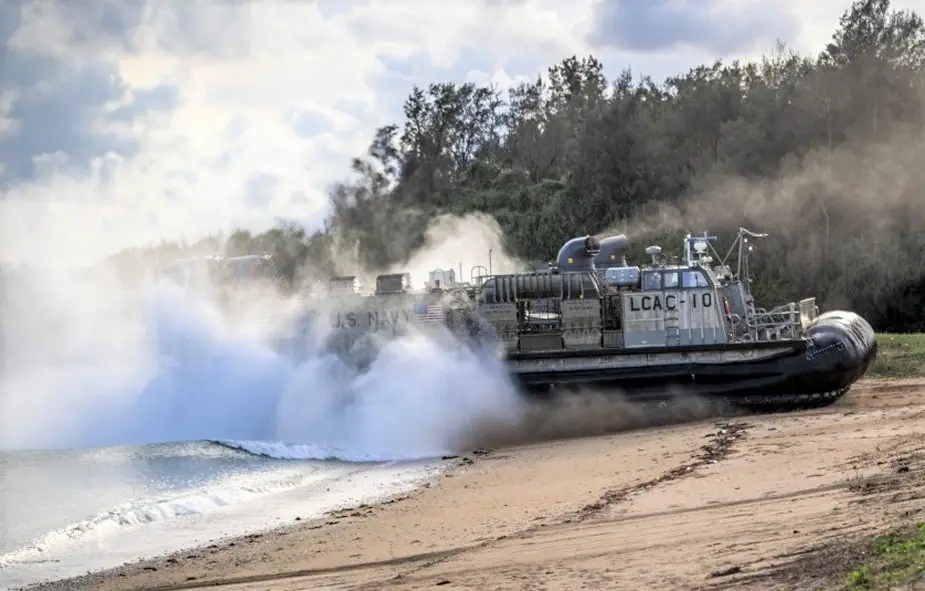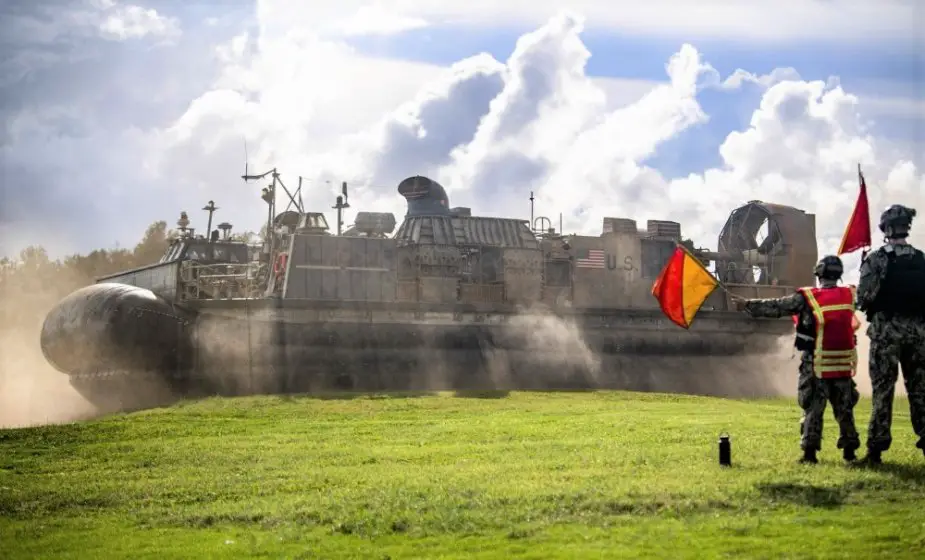Germantown, part of Expeditionary Strike Group Seven (ESG 7), along with the 31st Marine Expeditionary Unit, is operating in the U.S. 7th Fleet area of responsibility to enhance interoperability with allies and partners and serve as a ready response force to defend peace and stability in the Indo-Pacific region.
Germantown, part of Expeditionary Strike Group Seven (ESG 7), along with the 31st Marine Expeditionary Unit, is operating in the U.S. 7th Fleet area of responsibility to enhance interoperability with allies and partners and serve as a ready response force to defend peace and stability in the Indo-Pacific region.
Follow Navy Recognition on Google News at this link

Landing Craft, Air Cushion 10, assigned to Naval Beach Unit 7, currently attached to the amphibious dock landing ship USS Germantown (LSD 42), arrives at Blue Beach during amphibious operations (Picture source : U.S. Navy/Mass Communication Specialist 2nd Class Taylor DiMartino)
The expeditionary strike group (ESG) is a United States Navy concept introduced in the early 1990s, based on the Naval Expeditionary Task Force. The U.S. Navy fields nine expeditionary strike groups and ten carrier strike groups (CSGs), in addition to surface action groups. ESGs allow the U.S. to provide highly movable and self-sustaining naval forces for missions in various parts of the world.
The ESG concept combines the capabilities of surface action groups, submarines, and maritime patrol aircraft with those of amphibious ready groups (ARGs) and Marine expeditionary units (MEUs) (special operations capable) to provide greater combat capabilities to theater combatant commanders.[1] An expeditionary strike force (ESF) integrates the CSG and ESG with the sea-basing functions provided by the maritime prepositioning force (future) to provide an even more potent capability.
Expeditionary Strike Group SEVEN/Task Force 76 (Amphibious Force U.S. SEVENTH Fleet) is a United States Navy task force. It is at one and the same time operationally a task force of the United States Seventh Fleet and administratively, the USN's only permanently forward-deployed expeditionary strike group. It is based at the White Beach Naval Facility at the end of the Katsuren Peninsula in Uruma City, Okinawa, Japan.
CTF 76 conducts operations throughout the U.S. Seventh Fleet area of operations, which includes the Western Pacific Ocean and the Indian Ocean.

Boatswain’s Mate 3rd Class Juan Paulo Capati, left, from Vallejo, Calif., with Naval Beach Unit (NBU) 7, signals with flags as a ramp marshal, while Information Systems Technician 2nd Class Patrick Vowell, from Martin, Tenn., also with NBU 7, performs duties as senior ramp marshal as Landing Craft, Air Cushion 9, assigned to NBU 7, currently attached to the amphibious dock landing ship USS Germantown (LSD 42), departs Blue Beach during amphibious operations (Picture source : U.S. Navy/Mass Communication Specialist 2nd Class Taylor DiMartino)
U.S. Task Force 76 Headquarters staff is split between White Beach, Okinawa and Sasebo, on the island of Kyushu, Japan. The Command Element, Administration, Operations, Intelligence, Planning, C41 and Marine Liaison functions are located at White Beach to ensure effective, close coordination with the United States Marine Corps, specifically the 3rd Marine Expeditionary Brigade. We are also 7th Fleet’s co-located liaison with the III Marine Expeditionary Force. The Deputy Commander, along with Force Material and Training departments, are located on the Sasebo waterfront with the Amphibious and Mine Countermeasure ships and is responsible for the maintenance, training, and readiness of the Task Force.
Task Force 76 (Amphibious Force U.S. 7th Fleet), Expeditionary Strike Group Seven is the Commander, U.S. 7th Fleet's primary Navy advisor on amphibious matters in the Seventh Fleet Area of Operations (AO) and is responsible for conducting expeditionary warfare operations to support a full range of theater contingencies, ranging from humanitarian and disaster relief operations to full combat operations.
Task Force 76 assets operate from the sea to deter aggression by their presence and remain ready to support rapid mobilization in the event of crisis, conflict, or natural disaster. These assets bring unique capabilities to the fight and are the key enabler for the Marines' expeditionary operations ashore that can quickly and decisively neutralize any adversary.
Task Force 76's mission is immense, complex, challenging, and occasionally dangerous. The ultimate objective is to help maintain peace and stability in the region and protect our vital interests in the Pacific. In that venture, a flexible and powerful U.S. Navy amphibious force serves permanently forward deployed, ready to meet any challenge or tasking from our leaders.
Amphibious Force Seventh Fleet consists of Amphibious Squadron 11, USS Wasp, USS Blue Ridge, USS Green Bay, USS Ashland, USS Germantown, Mine Squadron 7, USS Chief, USS Pioneer, USS Patriot, USS Warrior, Helicopter Mine Countermeasure Squadron 14, Fleet Surgical Team 7, Helicopter Sea Combat Squadron 25, EOD Mobile Unit Five, and Naval Beach Unit 7.







